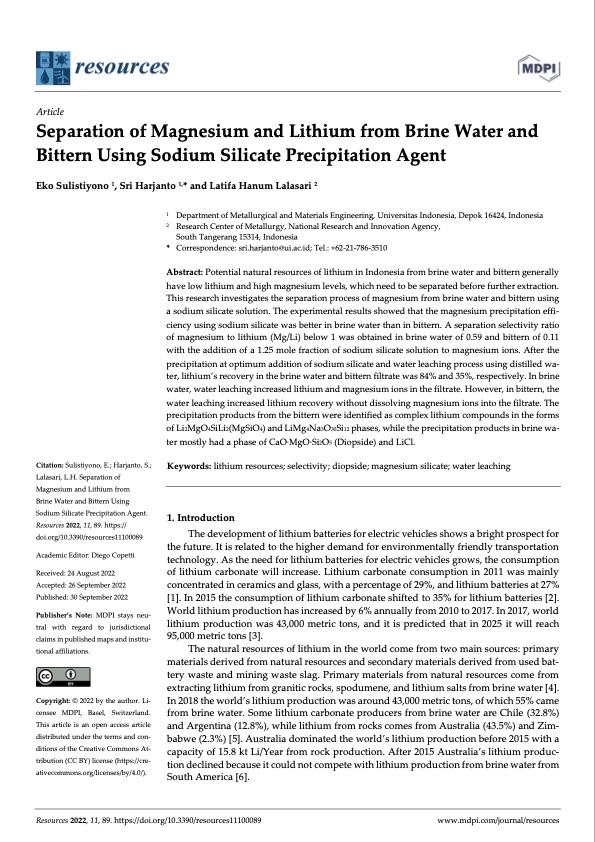
PDF Publication Title:
Text from PDF Page: 001
Article Separation of Magnesium and Lithium from Brine Water and Bittern Using Sodium Silicate Precipitation Agent Eko Sulistiyono 1, Sri Harjanto 1,* and Latifa Hanum Lalasari 2 Citation: Sulistiyono, E.; Harjanto, S.; Lalasari, L.H. Separation of Magnesium and Lithium from Brine Water and Bittern Using Sodium Silicate Precipitation Agent. Resources 2022, 11, 89. https:// doi.org/10.3390/resources11100089 Academic Editor: Diego Copetti Received: 24 August 2022 Accepted: 26 September 2022 Published: 30 September 2022 Publisher’s Note: MDPI stays neu- tral with regard to jurisdictional claims in published maps and institu- tional affiliations. Copyright: © 2022 by the author. Li- censee MDPI, Basel, Switzerland. This article is an open access article distributed under the terms and con- ditions of the Creative Commons At- tribution (CC BY) license (https://cre- ativecommons.org/licenses/by/4.0/). 1 Department of Metallurgical and Materials Engineering, Universitas Indonesia, Depok 16424, Indonesia 2 Research Center of Metallurgy, National Research and Innovation Agency, South Tangerang 15314, Indonesia * Correspondence: sri.harjanto@ui.ac.id; Tel.: +62-21-786-3510 Abstract: Potential natural resources of lithium in Indonesia from brine water and bittern generally have low lithium and high magnesium levels, which need to be separated before further extraction. This research investigates the separation process of magnesium from brine water and bittern using a sodium silicate solution. The experimental results showed that the magnesium precipitation effi- ciency using sodium silicate was better in brine water than in bittern. A separation selectivity ratio of magnesium to lithium (Mg/Li) below 1 was obtained in brine water of 0.59 and bittern of 0.11 with the addition of a 1.25 mole fraction of sodium silicate solution to magnesium ions. After the precipitation at optimum addition of sodium silicate and water leaching process using distilled wa- ter, lithium’s recovery in the brine water and bittern filtrate was 84% and 35%, respectively. In brine water, water leaching increased lithium and magnesium ions in the filtrate. However, in bittern, the water leaching increased lithium recovery without dissolving magnesium ions into the filtrate. The precipitation products from the bittern were identified as complex lithium compounds in the forms of Li2MgO4SiLi2(MgSiO4) and LiMg4Na3O30Si12 phases, while the precipitation products in brine wa- ter mostly had a phase of CaO·MgO·Si2O5 (Diopside) and LiCl. Keywords: lithium resources; selectivity; diopside; magnesium silicate; water leaching 1. Introduction The development of lithium batteries for electric vehicles shows a bright prospect for the future. It is related to the higher demand for environmentally friendly transportation technology. As the need for lithium batteries for electric vehicles grows, the consumption of lithium carbonate will increase. Lithium carbonate consumption in 2011 was mainly concentrated in ceramics and glass, with a percentage of 29%, and lithium batteries at 27% [1]. In 2015 the consumption of lithium carbonate shifted to 35% for lithium batteries [2]. World lithium production has increased by 6% annually from 2010 to 2017. In 2017, world lithium production was 43,000 metric tons, and it is predicted that in 2025 it will reach 95,000 metric tons [3]. The natural resources of lithium in the world come from two main sources: primary materials derived from natural resources and secondary materials derived from used bat- tery waste and mining waste slag. Primary materials from natural resources come from extracting lithium from granitic rocks, spodumene, and lithium salts from brine water [4]. In 2018 the world’s lithium production was around 43,000 metric tons, of which 55% came from brine water. Some lithium carbonate producers from brine water are Chile (32.8%) and Argentina (12.8%), while lithium from rocks comes from Australia (43.5%) and Zim- babwe (2.3%) [5]. Australia dominated the world’s lithium production before 2015 with a capacity of 15.8 kt Li/Year from rock production. After 2015 Australia’s lithium produc- tion declined because it could not compete with lithium production from brine water from South America [6]. Resources 2022, 11, 89. https://doi.org/10.3390/resources11100089 www.mdpi.com/journal/resourcesPDF Image | Separation of Magnesium and Lithium from Brine Water

PDF Search Title:
Separation of Magnesium and Lithium from Brine WaterOriginal File Name Searched:
resources-11-00089.pdfDIY PDF Search: Google It | Yahoo | Bing
Product and Development Focus for Infinity Turbine
ORC Waste Heat Turbine and ORC System Build Plans: All turbine plans are $10,000 each. This allows you to build a system and then consider licensing for production after you have completed and tested a unit.Redox Flow Battery Technology: With the advent of the new USA tax credits for producing and selling batteries ($35/kW) we are focussing on a simple flow battery using shipping containers as the modular electrolyte storage units with tax credits up to $140,000 per system. Our main focus is on the salt battery. This battery can be used for both thermal and electrical storage applications. We call it the Cogeneration Battery or Cogen Battery. One project is converting salt (brine) based water conditioners to simultaneously produce power. In addition, there are many opportunities to extract Lithium from brine (salt lakes, groundwater, and producer water).Salt water or brine are huge sources for lithium. Most of the worlds lithium is acquired from a brine source. It's even in seawater in a low concentration. Brine is also a byproduct of huge powerplants, which can now use that as an electrolyte and a huge flow battery (which allows storage at the source).We welcome any business and equipment inquiries, as well as licensing our turbines for manufacturing.| CONTACT TEL: 608-238-6001 Email: greg@infinityturbine.com | RSS | AMP |